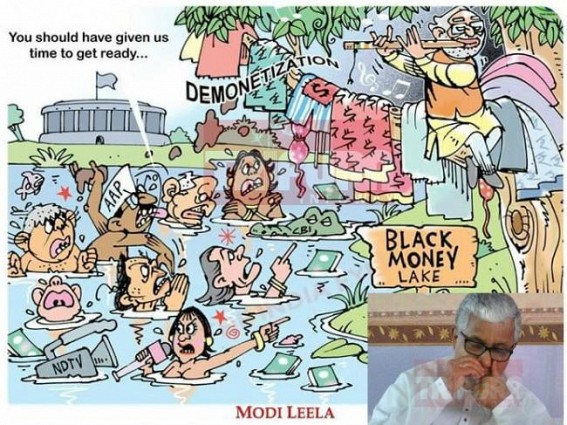Amulya Ganguli

PHOTO : Modi 'Leela' cartoon, Tripura CM resorting to 'NASSI' in public. TIWN File Pic
After the resounding victories of the Bharatiya Janata Party (BJP) in the UP assembly and Delhi municipal elections, the party increasingly appears to be politically invincible.
The three parties which offered some resistance to it in 2014 -- the AIADMK in Tamil Nadu, the Biju Janata Dal (BJD) in Odisha and Trinamool Congress in West Bengal -- are not in the pink of health today.
The AIADMK has all but collapsed after former Chief Minister Jayalalitha's death, the BJD has suffered serious reverses in the local polls and is feeling distinctly nervous while the Trinamool Congress has shot itself in the foot by its rather too soft a policy towards the Muslims, thereby alienating the Bengali middle-class Hindus, while several of its prominent personalities have become embroiled in scams.
Among the supposedly all-India parties, the fact that the Congress has fallen back on Sonia Gandhi to reach out to the regional leaders for an anti-BJP alliance shows that the party's attempts to prop up Rahul Gandhi haven't succeeded. It will not be easy for Sonia Gandhi, who is clearly not as fit and energetic as before, to take up the kind of role which she played to bring the non-BJP parties together in 2004.
Those who worsted the BJP in 2015, like Arvind Kejriwal in Delhi and Nitish Kumar in Bihar, have also suffered a decline, especially the former.
It is not surprising, therefore, that the BJP is now eying the east and the northeast as its new areas of conquest. The alacrity with which Congress MLAs in various states are joining the BJP shows that they regard their former adversary as a greener pasture for political and personal advancement.
It is not that the BJP doesn't face problems. For one, it has become a virtual one-man party with its dependence on Narendra Modi for success in even municipal elections. The party does not have a second line of defence if only because Modi has kept previously prominent party members like Arun Shourie and Yashwant Sinha, not to mention veterans like L.K. Advani, well outside the organisation.
For another, the economy has not been picking up in a manner which will sustain hope about the success of Modi's development agenda. The prime minister, therefore, has been speaking more about a pro-poor thrust a la Indira Gandhi than about rapid growth.
For a third, the government appears to be at a loss as to ways to deal with both external and internal threats posed by the Pakistan-based fidayeens (suicide bombers) and the Maoists, mainly in western and central India.
Even then, what evidently keeps the BJP going is Modi's popularity which has made him the most dominant person in today's politics, as Congress leader P. Chidambaram has said. Apart from the Prime Minister's seemingly boundless energy and rhetorical skills, his advantage is that there is no one in the opposition camp who can match his wide appeal.
Not only that, his adversaries have undermined themselves by self-defeating moves as when Sonia Gandhi stalled the Manmohan Singh government's forward march on the economic front by opting for extravagant populist measures, thereby handing over her own government's development agenda on a platter to Modi. As Chidambaram ruefully admitted later, the government should not have taken "the foot off the accelerator of reforms".
Similarly, Kejriwal came to power with the assurance of providing a clean government as promised by his one-time mentor, Anna Hazare, who pleaded for the setting up of a Lokpal, an anti-corruption ombudsman. But Kejriwal's own internal ombudsman, Admiral L. Ramdas, had to leave the Aam Admi Party (AAP) for questioning the Chief minister's authoritarian style, which also led to the ouster of the latter's former allies, Yogendra Yadav and Prashant Bhushan.
By the time Kejriwal had concluded the purge of his own party, it was clear that governance, whether a clean one or not, was not his primary objective, but an insatiable craving for power. Once this obsession became clear, it was obvious that his party's days were numbered since the aam admi or the common man after whom the outfit was named had seen through his pretensions. The AAP's defeat in Delhi was only to be expected, therefore, after its setbacks in Punjab and Goa.
Like Kejriwal, Nitish Kumar, too, has failed to live up to the expectations that he had aroused during his earlier stint as Chief Minister when he succeeded in ridding Bihar of the lawlessness -- or the jungle raj, as it was called -- which was rampant during the tenures of Rashtriya Janata Dal (RJD) leaders Laloo Prasad Yadav and his wife, Rabri Devi.
But now, as an ally of Laloo Prasad while Rabri Devi is calling for her son, Tejaswi, to be elevated from Deputy Chief Minister to Chief Minister, Nitish Kumar's focus is somehow to hold on to power.
So, who will stop the BJP? Not only is there no one in sight, but there is little chance of the opposition parties being able to put together an anti-BJP combine because of their fractious internal relations.
Besides, they lack a forward-looking economic agenda which appeals to the young as Modi's Make In India, Digital India, start-ups and other programmes do.
(Amulya Ganguli is a political analyst. The views expressed are personal. He can be reached at amulyaganguli@gmail.com)
- Why Modi’s BJP swept key India regional elections
- TIWN’s landmark legal victory against BJP Govt’s Illegal attacks to shutdown fearless Media
- India to be world's third-largest economy by 2030 -S&P Global Ratings
- Tripura's Dark Era : Mafia style Brutal attacks on Journalists, fight for your Citizen rights !
- How to access tripurainfoway.com via HOLA from India



